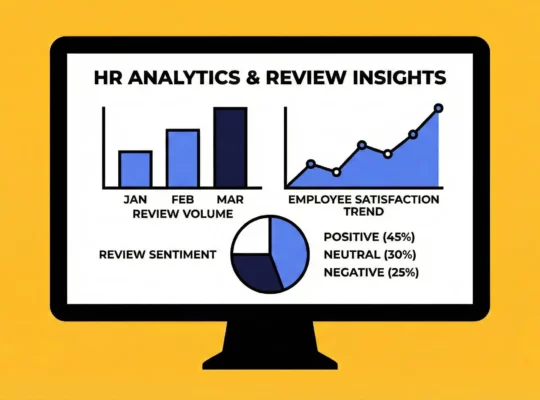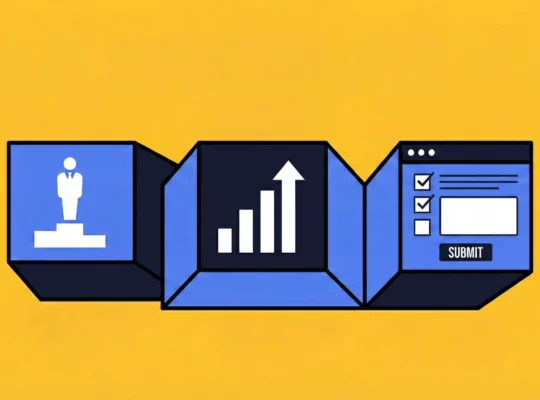Performance reviews are more than just a formality – they’re a springboard for employee growth and organizational success. Effective reviews provide a platform to discuss accomplishments, identify areas for development, and set clear goals for the future. This ongoing dialogue fosters a sense of ownership and accountability within employees while allowing managers to provide targeted support and guidance.
At Review.jobs, we believe in the power of asking the right questions to unlock potential and fuel engagement. This guide equips you with the essentials for conducting effective performance reviews and transforming them from a checklist into a catalyst for growth.
Table of Contents
I. Importance of Performance Reviews
II. Setting the Stage for an Effective Performance Review
III. Top 20 Performance Review Questions by Categories
IV. Post-Review Steps: Action Plans and Continuous Feedback
I. Importance of Performance Reviews
Definition and Purpose
Performance reviews are formal evaluations of an employee’s work performance over a specific period. They serve multiple purposes, including assessing employee performance, providing feedback, and setting future goals. These reviews are essential for aligning individual contributions with the company’s strategic objectives.
Benefits for Both Employees and Employers
Performance reviews offer numerous benefits. For employees, they provide clarity on areas of improvement, recognition for achievements, and a platform for discussing career aspirations and professional development.
As for employers, they help identify employee strengths, facilitate performance management, and improve overall productivity and engagement.
II. Setting the Stage for an Effective Performance Review
Preparing for the Review
Importance of Thorough Preparation
Thorough preparation for a performance review ensures a productive and insightful discussion. When managers and employees come prepared, it reflects their commitment to the process and sets a positive tone for the review session.
Proper preparation helps identify specific areas of improvement and employee strengths and sets the stage for meaningful performance management.
Gathering Relevant Performance Data
Effective performance reviews rely on a solid foundation of data. This data goes beyond just numbers and metrics – it paints a holistic picture of an employee’s contributions, challenges, and areas for growth. Here are some key tips to ensure you’re gathering the most relevant performance data for your next review:
- Review past performance records: Look at previous performance reviews and performance appraisal reports to identify patterns and areas for improvement.
- Collect feedback: Seek input from colleagues, team members, and other managers and employees who have worked closely with the employee.
- Track progress: Use performance tracking tools to monitor progress on specific goals and projects.
- Analyze metrics: Evaluate key performance indicators (KPIs) relevant to the employee’s role and responsibilities.
Setting Clear Objectives for the Review Session
Clear objectives act as a roadmap, guiding the conversation and ensuring all critical points are covered. Here are some steps to consider when crafting clear objectives for your next performance review session:
- Define the purpose: Determine whether the review will focus on past performance, setting future goals, or both.
- Outline key topics: Prepare an agenda that includes employee performance, professional growth, and areas of improvement.
- Set expectations: Communicate the objectives and agenda to the employees beforehand to ensure they are prepared and feel comfortable.
Creating a Positive Environment
Ensuring a Comfortable Setting
A successful performance review hinges on open and honest communication. Choose a private and quiet location where both parties can speak freely without interruptions. Make sure the seating arrangement promotes a sense of equality and collaboration, rather than a hierarchical dynamic.
Importance of a Two-Way Conversation
Performance reviews shouldn’t be a monologue; they’re a powerful opportunity for a two-way conversation. When both managers and employees actively participate, share perspectives, and truly listen to each other, the benefits are manifold.
Read this article about performance review phrases.
This approach not only helps in gaining a comprehensive understanding of the employee’s current role and performance but also strengthens the relationship between the manager and the employee.
Encouraging Openness and Honesty
When employees feel comfortable expressing themselves honestly, the conversation becomes more productive and leads to valuable growth opportunities. Here are some key strategies to encourage openness and honesty during the review process:
- Ask open-ended questions: Use questions that require more than a yes or no answer to encourage detailed responses.
- Express appreciation: Recognize and appreciate the employee’s contributions and efforts to make them feel valued.
- Provide constructive feedback: Offer specific examples and suggestions for improvement in a supportive manner.
- Foster trust: Build a trusting relationship by being transparent and respectful throughout the review process.
III. Top 20 Performance Review Questions by Categories
Accomplishments and Contributions
Performance review questions focusing on accomplishments and contributions help highlight an employee’s achievements and the impact of their work. These questions encourage employees to reflect on their successes and recognize the value they bring to the team and organization.
Questions to Highlight Achievements
- What was your most significant work accomplishment since your last review and why?
- Which project are you most proud of and why?
Goals and Future Planning
Questions about goals and future planning provide insight into an employee’s career aspirations and long-term objectives. These questions help align individual goals with the company’s strategic direction and support professional development.
Questions About Future Objectives and Career Aspirations
- What do you plan to accomplish this year?
- Where do you see yourself in the next five years?
Self-Assessment and Reflection
Encouraging self-assessment and reflection allows employees to evaluate their performance and identify their strengths and areas of improvement. This process fosters self-awareness and motivates employees to take ownership of their professional growth.
Questions That Encourage Self-Evaluation
- Are there areas where you feel you could improve?
- What skills would you like to develop further?
Feedback and Improvement
Feedback and improvement questions are designed to identify areas where employees can grow and enhance their performance. These questions also allow employees to share any obstacles they encountered and how they overcame them.
Questions to Identify Areas for Growth
- What could you do differently to improve your performance?
- What obstacles did you face this year and how did you overcome them?
Organizational Alignment
Questions about organizational alignment help gauge an employee’s understanding of the company’s goals and how their role contributes to achieving them. These questions ensure that employees are aligned with the overall mission and objectives of the organization.
Questions to Gauge Understanding of Company Goals
- What are the organization’s primary drivers of success?
- How do you see your role contributing to the company’s goals?
Resource and Support Needs
Understanding an employee’s resource and support needs is essential for enabling them to perform their job effectively. These questions uncover any gaps in resources or tools that may be hindering their performance.
Questions to Uncover Support Requirements
- Do you have everything you need to perform your job effectively?
- What resources or tools could help you be more effective in your role?
Team Collaboration and Contribution
Evaluating an employee’s contribution to their team and their ability to collaborate is essential for fostering a collaborative and productive work environment. These questions provide insights into how employees view their role within the team and their support for colleagues.
Questions About Team Contribution
- How do you feel you have contributed to your team’s success?
- How have you supported your colleagues in achieving their goals?
Feedback and Job Satisfaction
Fostering a culture of open communication allows employees to provide valuable insights and suggestions for improvement. The following questions can help gauge employee sentiment and identify areas where the company can enhance its offerings.
Questions About Feedback and Job Satisfaction
- What feedback do you have for the company?
- How do you manage work-life balance?
IV. Post-Review Steps: Action Plans and Continuous Feedback
Action Plans
Creating actionable plans post-review is essential for translating feedback into tangible progress. An action plan provides a roadmap for employees to follow, ensuring that the insights gained during the performance review lead to meaningful improvements and growth.
Importance of Creating Actionable Plans Post-Review
Actionable plans are crucial because they:
- Clarify expectations: Employees understand exactly what is expected of them and how to achieve it.
- Provide direction: Clear steps guide employees on addressing areas of improvement and building on their strengths.
- Ensure accountability: Both employees and managers can track progress and hold each other accountable for meeting set goals.
Tips for Setting Measurable Goals
Setting measurable goals ensures that progress can be tracked and evaluated effectively. Here are some tips:
- Use SMART criteria: Goals should be Specific, Measurable, Achievable, Relevant, and Time-bound.
For example, “Increase sales by 10% over the next quarter” is a SMART goal. - Break down larger goals: Divide ambitious objectives into smaller, manageable tasks to maintain motivation and focus.
- Align goals with company objectives: Ensure that individual goals contribute to the broader organizational mission, enhancing employee performance and company success.
- Set deadlines: Establish clear timelines for each goal to create a sense of urgency and prioritization.
Continuous Feedback
Continuous feedback is a cornerstone of effective performance management. It promotes ongoing development and keeps employees engaged by providing regular insights into their performance and progress.
Encouraging Regular Check-Ins and Ongoing Communication
Regular check-ins and ongoing communication ensure that feedback is timely and relevant. Consider the following strategies:
- Schedule regular meetings: Bi-weekly or monthly one-on-one meetings between managers and employees help maintain open lines of communication and address issues promptly.
- Use multiple channels: Leverage various communication tools, such as emails, instant messaging, and project management platforms, to provide consistent feedback. Make sure to initiate verbal communication regularly to maintain good relationships with your employees.
- Create a feedback-friendly culture: Encourage employees to seek and give feedback regularly, making it a natural part of the work environment.
Benefits of Continuous Feedback Loops
- Immediate improvement: Employees can quickly address issues and adjust their work, enhancing overall performance.
- Increased engagement: Regular feedback keeps employees motivated and invested in their personal and professional growth.
This, along with employee engagement programs, can guarantee you a thriving team! - Stronger relationships: Continuous dialogue between managers and employees fosters trust and collaboration.
- Proactive problem-solving: Potential challenges are identified and addressed before they escalate, ensuring smoother operations and better outcomes.
Effective performance reviews yield a multitude of benefits. Employees gain clarity on expectations, receive targeted feedback for improvement, and feel valued for their contributions. At Review.jobs, we encourage managers to implement these practices to create a more engaging and supportive work environment.
Remember, the key lies in tailoring your approach to your organization’s unique needs. By implementing these practices and fostering a continuous feedback loop, you can create a thriving work environment where employees are empowered to learn, grow, and excel.





